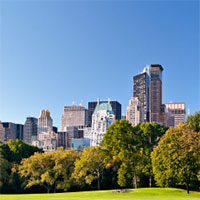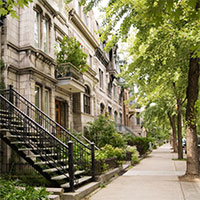Tree Facts
What can a tree do for you? A lot. Check out all the ways—sometimes unexpected—that trees positively affect us, our communities, and our world.
 Trees help clean our air.
Trees help clean our air.
-
Global forests removed about one-third of fossil fuel emissions annually from 1990 to 2007.
share U.S. Forest Service, 2011 -
Trees remove pollution from the atmosphere, improving air quality and human health.
share U.S. Forest Service, 2013-
In Los Angeles, trees remove nearly 2,000 tons of air pollution each year.
share U.S. Forest Service, 2011 -
In Chicago, trees remove more than 18,000 tons of air pollution each year.
share U.S. Forest Service, 2013 -
In Greater Kansas City, trees remove 26,000 tons of air pollution each year.
share U.S. Forest Service, 2013
-
In Los Angeles, trees remove nearly 2,000 tons of air pollution each year.
-
Roadside trees reduce nearby indoor air pollution by more than 50%.
share Lancaster University, United Kingdom, 2013
 Trees contribute to our health.
Trees contribute to our health.
-
A study of 10 cities found community forests save an average of one life each year. In New York City, trees save an average of eight lives every year.
share U.S. Forest Service, 2013 -
Office workers with a view of trees report significantly less stress and more satisfaction.
share Chungbuk National University, South Korea, 2007
 Trees provide us with oxygen.
Trees provide us with oxygen.
-
One large tree can provide a day’s supply of oxygen for up to four people.
share U.S. Department of Agriculture, 2015 -
More than 20% of the world’s oxygen is produced in the Amazon Rainforest
share Rain Forest Alliance
 Trees help clean our drinking water.
Trees help clean our drinking water.
-
Forested watersheds provide quality drinking water to more than 180 million Americans.
share U.S. Forest Service, 2013 -
In 1997, New York City spent $1.5 billion to preserve the forested watershed that supplies New York City’s drinking water by purchasing thousands of upstate acres of forested watershed. A filtration plant large enough to clean New York City’s water supply would have cost more than $6 billion dollars.
share Ecosystem Marketplace, 2006-
Today, New Yorkers enjoy some of the cleanest drinking water in the world, and New York City has won regional water taste competitions.
share New York City Department of Environmental Protection, 2013
-
Today, New Yorkers enjoy some of the cleanest drinking water in the world, and New York City has won regional water taste competitions.
 Trees provide much-needed cooling.
Trees provide much-needed cooling.
-
Trees lower surface and air temperatures by providing shade. Shaded surfaces may be 20–45°F cooler than the peak temperatures of unshaded materials.
U.S. EPA- Trees cool the city by up to 10°F by shading our homes and streets and releasing water vapor into the air through their leaves.
-
Evaporation of water from trees has a cooling influence.
share Carnegie Institution, 2011
 Trees help reduce the effects of climate change.
Trees help reduce the effects of climate change.
-
Trees absorb carbon dioxide (CO2), removing and storing the carbon while releasing the oxygen back into the air.
- In one year, an acre of mature trees absorbs the amount of CO2 produced by a car driven 26,000 miles.
-
During one year, a mature tree will absorb more than 48 pounds of carbon dioxide from the atmosphere and release oxygen in exchange.
share European Environment Agency-
Nearly 20 pounds of carbon dioxide are produced from burning one gallon of non-ethanol gasoline.
share U.S. Energy Information Administration
-
Nearly 20 pounds of carbon dioxide are produced from burning one gallon of non-ethanol gasoline.
 Trees help us save energy.
Trees help us save energy.
-
Trees properly placed around buildings can reduce air conditioning needs by 30% and can save 20–50% in energy used for heating.
share U.S. Forest Service-
The average Cincinnati community tree saves the average household $56 annually in cooling costs by reducing electricity use. More than 85,000 Cincinnati community trees save residents $4.8 million.
2011
-
The average Cincinnati community tree saves the average household $56 annually in cooling costs by reducing electricity use. More than 85,000 Cincinnati community trees save residents $4.8 million.
-
Carefully positioned trees can reduce a household’s energy consumption for heating and cooling by up to 25%. Computer models devised by the U.S. Department of Energy predict that the proper placement of only three trees can save an average household between $100 and $250 in energy costs annually.
share Energy.gov
 Trees benefit wildlife.
Trees benefit wildlife.
-
Trees provide vital wildlife habitat.
share U.S. Forest Service, 2010-
In British Columbia, Canada, more than 80 wildlife species depend on trees.
share Ministry of Environment, Lands and Parks, British Columbia
-
In British Columbia, Canada, more than 80 wildlife species depend on trees.
-
Trees and forests provide important species range. Many animals have a range of hundreds of square miles. The mountain lion of North America, for instance, has a range of nearly 400 square miles.
share National Geographic
 Trees help reduce crime.
Trees help reduce crime.
-
In Baltimore, a 10% increase in tree canopy corresponded to a 12% decrease in crime.
share University of Vermont and U.S. Forest Service, 2012 -
Among minor crimes, there is less graffiti, vandalism and littering in outdoor spaces with trees as a part of the natural landscape than in comparable plant-less spaces.
share University of Washington -
Chicago public housing residents with nearby trees and natural landscapes reported 25% fewer acts of domestic aggression and violence.
share University of Illinois, Urbana-Champaign, 2001
 Trees are a good investment of our public dollars.
Trees are a good investment of our public dollars.
-
Every dollar spent on planting and caring for a community tree yields benefits that are two to five times that investment—benefits that include cleaner air, lower energy costs, improved water quality and storm water control and increased property values.
U.S. Forest Service, 2011-
In Indianapolis, each dollar invested in the city’s community trees yielded $5.55 in benefits.
share State of Indiana DNR, 2008 -
In New York City, it has been calculated that community trees provide $5.60 in benefits for every dollar spent on tree planting and care.
share 2007
-
In Indianapolis, each dollar invested in the city’s community trees yielded $5.55 in benefits.
-
The mature street trees in Beverly Hills, California, are worth $450 million.
share 1991 -
A cost-benefit analysis of the Berkeley, California, tree canopy indicated that each camphor tree had an annual net benefit to the city and its residents of nearly $12,500, each shamel ash showed a $9,600 annual net benefit, and each London planetree had an annual net benefit of more than $8,700 per tree.
share 2005
 Trees increase our property values.
Trees increase our property values.
-
In Portland, Oregon, homes with street trees sold for $7,130 more, on average, and 1.7 days more quickly.
share U.S. Forest Service, 2008- Neighboring houses within 100 feet of street trees sold for $1,688 more, on average.
- The sale premium of having street trees was the same as adding 129 square feet of finished space.
-
In Fulton County (Atlanta), Georgia, mature trees positively influenced home sale prices. Homes sold for nearly $105,000 more in neighborhoods with mature trees.
University of Georgia, 2002
